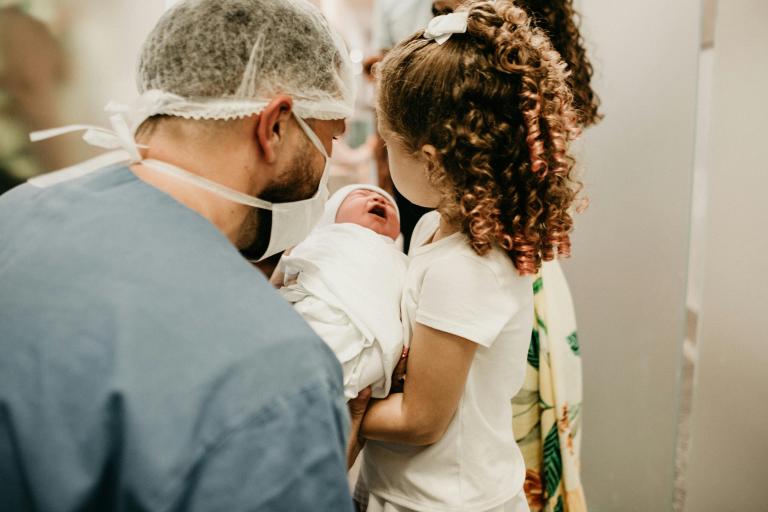Labour can be unpredictable; these top tips are to help you prepare
Your partner might feel contractions (uterine pains) that get stronger over time until the baby is born.
The amniotic fluid sac (the water around your baby in the womb) might break but this sometimes does not happen until the baby is born and is not always a gush of fluid like you see on TV!
Sometimes labour is recommended to be induced (started).
You can contact your midwife or the maternity unit at any time for advice. We offer parent education classes at our family hubs. These classes can help you learn what labour looks like. To find out more about the classes, ask your midwife for further information.
If you are booked to have your baby at the RVI Maternity Unit, call ahead if you think your partner is in labour. This way, the staff will be ready for you. The telephone number for the labour line is 0191 2826363.
When attending the unit you will need to go to maternity reception (Leazes wing, level 4), or the birthing centre (Leazes Wing, level 3. This is the level where you enter the hospital).
You will be greeted by a midwife who will run a set of observations and examine your partner. If labour is happening, you will move into a private room where you will stay until your baby is born.
Often babies don’t make an appearance by their due date. If this happens, the hospital might offer your partner an induction at about 41 weeks.
Visiting hours on the ward are 8am-8pm for birth partners. Siblings of the baby are the only children allowed on the ward.

Inducing Labour
Labour can be induced for various medical reasons. Your doctor or midwife will explain this if it is suggested.
This process requires you to attend the delivery suite (the staff will give you a time the day before). The midwife will assess your partner and explain the process to begin labour. They may give a hormone (vaginally) to stimulate the cervix or break the waters around the baby. Sometimes a hormone drip into the arm is also needed. Once your partner is in labour, or if the drip is needed, you will then move into a delivery room until the baby is born.
Sometimes, babies can get stressed during labour. Your partner might also feel tired and need some extra support from a doctor to help the baby be born. This could be via a C-section or using forceps or a ventous (suction cup) to help guide your baby out safely.
During a vaginal birth, some birthing parents may need a cut called an episiotomy. This cut is made in the skin between the vagina and anus, known as the perineum. It helps control tearing or helps with delivering the baby. If your partner has a tear or needs an episiotomy, the midwife or doctor will repair (suture) this after the baby and placenta are delivered. This will be done with some local anaesthetic for pain relief.
C-sections
Elective C-section
If your partner has a planned C-section, the hospital will give you a date and time to arrive.
A midwife will welcome you and get your partner ready for theatre. They will check your partner's health. The doctor and anaesthetist will then attend to discuss the procedure. When your partner is ready for theatre, staff will ask you to change into burgundy colour scrubs, shoes, and a hair net. These special clothes are all provided to help keep theatre as clean as possible. Then, you can support your partner during the procedure.
Emergency C-Section
Doctors may need to perform an emergency C-section if the health of your partner or baby is at risk. This may happen during labour or before labour starts. If someone recommends this, things can move very quickly. Staff will always try to keep you informed at each point, but we understand this can be scary for partners too. Although it's rare sometimes your partner might need a general anaesthetic - this means your partner will be asleep for surgery. The medical team will always try to avoid this if possible. If it does need to happen, you will be asked to wait in your private room until the operation is complete.
Please ask staff any questions you might have; you’re not alone, we’re always there with a cup of tea.
After the C-section, you’ll change and meet your partner in the recovery bay. You both will have time with your baby until they move to the postnatal ward.
Support for you post-birth
Birth can be an amazing and sometimes overwhelming experience. If any of these situations upset you, the RVI offers a birth reflection service. Dads can attend this service with their partners. At this appointment a midwife will discuss the details of the birth.
This process isn’t a counselling service. Still, parents have found it helpful when the experience feels traumatic.
Please speak to your midwife for further information about the Birth Reflections Service.
There is also the national Birth Trauma Association who have a dad with lived experience of birth trauma offering peer support: https://www.birthtraumaassociation.org/
